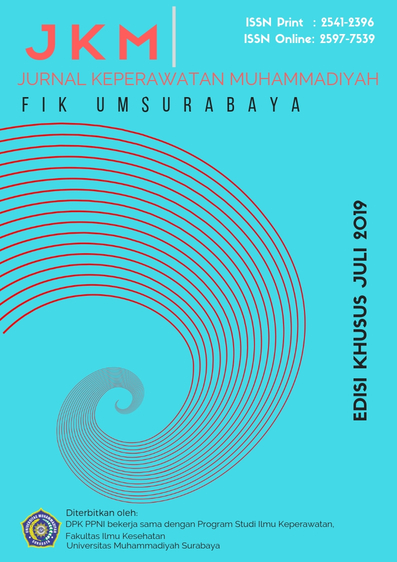Gambaran Strategi Program Studi Keperawatan Untuk Meningkatkan Kelulusan Mahasiswa Dalam Uji Kompetensi : Literatur Review
DOI:
https://doi.org/10.30651/jkm.v4i2.2343Keywords:
Strategi program studi, Uji Kompetensi, UKNI, NCLEX-RNAbstract
Description departement of nursing strategy to increase students approach in competency test: literatur review
Â
Â
Abstract
Background: Nursing competency exam is a process to measure the knowledge, skills and performance of student in colleges that obtaining nursing department which aimed to achieve the standard of competency of alumnae who meet up with work proficiency standard. The nursing competency exam has been conceded by twelve times in Indonesia, with the National UKNI results by period VII was 37.87%, in period VIII was 37.42%, on period IX was 33.46% and on period X was 39,3%. The results show how pure the passing grad rate of students in UKNI. Methods: the databases used in this literature are Pubmed, Science Direct, and Wiley online. Result: There were 14 articles, but those who comply with the inclusion criteria were 7 articles. Some studies show a number of institutional strategies to improve student passing grade in NCLEX-RN competence exam. Discussion : online caching, nursing clinic courses, remedial policies, fourteen steps Exit Examination Review, a course in focusing to solving clinical decision problems, preparation competency test courses, course work and Adaptive Quizzing System tests, the educational basic curriculum establishment, learning methods, the students risk Adaptive Quizzing program detection, learning style, confidence and Locus of Control (LOC) as some strategi of institution to improve student passing grade in NCLEX-RN competence exam. Conclusion: to increase the percentage of student graduation in the competency test it takes the seriousness of the institution to foster and prepare students to take the competency test.
References
DAFTAR PUSTAKA
Benefiel, D. (2011). The story of nurse licensure. Nurse Educator, Lippincott Williams & Wilkins, 36(1), 16–20. https://doi.org/10.1097/NNE.0b013e3182001e82
Brodersen, L. D., & Mills, A. C. (2014). A Comparison of Two Nursing Program Exit Exams That Predict Outcome. CIN: Computers, Informatics, Nursing &, 32(8), 404–412. https://doi.org/10.1097/CIN.0000000000000081
Chavis, P. I. (2017). Self-esteem, locus of control, and first-time NCLEX-RN passage of BSN students at historically black colleges and universities. Nursing Education Perspectives, 38(6), 320–324. https://doi.org/10.1097/01.NEP.0000000000000227
Cole, L. G., & Adams, M. H. (2014). A multifaceted progression approach to enhancing student success. Nurse Educator, 39(6), 285–289. https://doi.org/10.1097/NNE.0000000000000084
Corrigan-Magaldi, M., Colalillo, G., & Molloy, J. (2014). Faculty-facilitated remediation: A model to transform at-risk students. Nurse Educator, 39(4), 155–157. https://doi.org/10.1097/NNE.0000000000000043
Cox-Davenport, A., R., & Phelan, J. C. (2015). Laying the Groundwork for NCLEX Success: An Exploration of Adaptive Quizzing as an Examination Preparation Method. CIN - Computers Informatics Nursing, 33(5), 208–215. https://doi.org/10.1097/CIN.0000000000000140
Hartina, A., Tahir, T., Nurdin, N., & Djafar, M. (2018). Faktor Yang Berhubungan Dengan Kelulusan Uji Kompetensi Ners Indonesia (Ukni) Di Regional Sulawesi. Jurnal Persatuan Perawat Nasional Indonesia (JPPNI), 2(2), 65. https://doi.org/10.32419/jppni.v2i2.84
Hendryadi, H. (2017). Pengembangan skala locus of control. Jurnal Riset Manajemen Dan Bisnis (JRMB) Fakultas Ekonomi UNIAT, 2. Retrieved from https://www.researchgate.net/publication/323255351_PENGEMBANGAN_SKALA_LOCUS_OF_CONTROL
Hooper, J. I., & Ayars, V. D. (2017). How Texas Nursing Education Programs Increased NCLEX Pass Rates and Improved Programming. Journal of Nursing Regulation, 8(3), 53–58. https://doi.org/10.1016/S2155-8256(17)30160-6
Hwang, D.-Y., & Henson, R. K. (2002). A Critical review of the Literature on Kolb’s Learning Style Inventory with Implications for Score Reliability. Retrieved December 23, 2018, from https://eric.ed.gov/?id=ED466696
Undang-Undang Republik Indonesia Nomor 38 Tahun 2014 Tentang Keperawatan (2014). Jakarta. Retrieved from www.kemenkopmk.go.id/content/uu-nomor-38-tahun-2014
Johnson, L. J. (2015). Student Perceptions of Effective Learning Strategies for National Council Licensure Examination Preparation. ProQuest Dissertations and Theses, 181. Retrieved from https://search.proquest.com/docview/1680289377?accountid=12459%5Cnhttp://sfx.unimi.it:9003/unimi?url_ver=Z39.88-2004&rft_val_fmt=info:ofi/fmt:kev:mtx:dissertation&genre=dissertations+%26+theses&sid=ProQ:ProQuest+Dissertations+%26+Theses+Global%3A+The+Huma
Kang, M.-H., Kwon, O.-Y., Kim, Y.-W., Kim, J.-W., Kim, T.-H., Oh, T.-Y., … Oh, J.-S. (2016). Is there an agreement among the items of the Korean physical therapist licensing examination, learning objectives of class subjects, and physical therapists’ job descriptions? Journal of Educational Evaluation for Health Professions, 13, 3. https://doi.org/10.3352/jeehp.2016.13.3
Kariasa, I. M., Tahir, T., Rahayu, U., Santoso, A., Slametiningsih, Soesanto, E., … Wahyuni, S. (2018). SiNERSI Hadirkan Sukses Uji Kompetensi Ners Indonesia. Jakarta: Asosiasi Institusi Pendidikan Ners Indonesia (AIPNI).
Kholifah, S., & Kusumawati, W. (2016). Hambatan Lulusan Ners Dalam Menghadapi Uji Kompetensi Ners Indonesia. The Indonesian Journal of Health Science, 7(1), 40–47.
Lockie, N. M., Van Lanen, R. J., & Mc Gannon, T. (2013). Educational implications of nursing students’ learning styles, success in chemistry, and supplemental instruction participation on national council licensure examination-registered nurses performance. Journal of Professional Nursing, 29(1), 49–58. https://doi.org/10.1016/j.profnurs.2012.04.003
Lown, S. G., & Hawkins, L. A. (2017). Learning Style as a Predictor of First-Time NCLEX-RN Success: Implications for Nurse Educators. Nurse Educator, 42(4), 181–185. https://doi.org/10.1097/NNE.0000000000000344
Opsahl, A. G., Auberry, K., Sharer, B., & Shaver, C. (2018). A comprehensive educational approach to improving NCLEX-RN pass rates. Nursing Forum, 53(4), 549–554. https://doi.org/10.1111/nuf.12285
Rassool GH, R. S. (2007). Learning style preferences of undergraduate nursing students, 21(32), 35–41. Retrieved from https://www.ncbi.nlm.nih.gov/pubmed/17479786
Riggs, L. (2012). Nursing Students’ Awareness and Intentional Maximization of their Learning Styles. ERIC, 27–44. Retrieved from https://eric.ed.gov/?id=EJ973401
RistekDikti. (2014). Registrasi Online Uji Kompetensi NERS 2. Retrieved February 19, 2018, from http://ukners.dikti.go.id/pendaftaran/pengumuman
Shoemaker, J. R., Chavez, R. A., Keane, P., & Butz, S. (2017). Effective Utilization of Computerized Curricular Assistive, 43081(April), 194–200.
Shubina, I. (2017). Locus of control , feeling of happiness and self-esteem : interrelation analysis. International Journal of Scientific Research and Management (IJSRM), 5(11), 7563–7575. https://doi.org/10.18535/ijsrm/v5i11.27
Thomas, M. H., & Baker, S. S. (2011). NCLEX-RN success: Evidence-based strategies. Nurse Educator, 36(6), 246–249. https://doi.org/10.1097/NNE.0b013e3182333f70
Downloads
Published
Issue
Section
License
- Penulis tetap memegang hak atas karyanya dan memberikan hak publikasi pertama kepada jurnal ini yang secara simultan karya tersebut dilisensikan di bawah:Â Creative Commons Attribution-ShareAlike 4.0 International (CC BY-SA 4.0)













